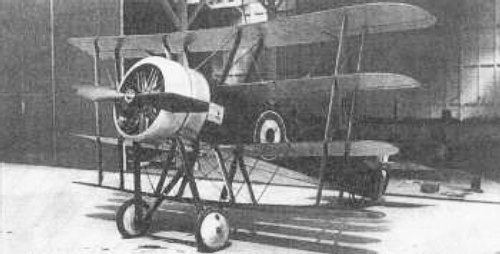Wight Quadruplane on:
[Wikipedia]
[Google]
[Amazon]
The Wight Quadruplane, also referred to as the Wight Type 4, was a British single seat 

quadruplane In aviation, a multiplane is a fixed-wing aircraft-configuration featuring multiple wing planes. The wing planes may be stacked one above another, or one behind another, or both in combination.
Types having a small number of planes have specific nam ...
fighter aircraft built by J Samuel White & Company Limited (Wight Aircraft) during World War I
World War I (28 July 1914 11 November 1918), often abbreviated as WWI, was one of the deadliest global conflicts in history. Belligerents included much of Europe, the Russian Empire, the United States, and the Ottoman Empire, with fightin ...
. Testing revealed design deficiencies and after the only example was involved in a crash, further work on the aircraft was abandoned.

Design and development
The Quadruplane serial no N546 was a prototype designed by Wight Aircraft general manager and design chief Howard T. Wright in 1916. Inspired by theSopwith Triplane
The Sopwith Triplane was a British single seat fighter aircraft
Fighter aircraft are fixed-wing military aircraft designed primarily for air-to-air combat. In military conflict, the role of fighter aircraft is to establish air superiori ...
and other multi-wing aircraft of its time, it had an unusual arrangement in which the fuselage
The fuselage (; from the French ''fuselé'' "spindle-shaped") is an aircraft's main body section. It holds crew, passengers, or cargo. In single-engine aircraft, it will usually contain an engine as well, although in some amphibious aircraf ...
was placed between the middle two wings with upper and lower wings attached by struts.
Another remarkable feature was that its wingspan
The wingspan (or just span) of a bird or an airplane is the distance from one wingtip to the other wingtip. For example, the Boeing 777–200 has a wingspan of , and a wandering albatross (''Diomedea exulans'') caught in 1965 had a wingspan o ...
was less than the overall length. The wings were cambered on the leading and trailing edges with a flat middle section. This wing design proved to be very inefficient. Power was provided by a Clerget 9Z
Clerget-Blin (full name being ''Société Clerget-Blin et Cie'') was a French precision engineering company formed in 1913 by the engineer and inventor Pierre Clerget and industrialist Eugène Blin. In 1939, the company was absorbed into the ''G ...
nine-cylinder air cooled rotary engine
The rotary engine is an early type of internal combustion engine, usually designed with an odd number of cylinders per row in a radial configuration. The engine's crankshaft remained stationary in operation, while the entire crankcase and its ...
and it was to be armed with two Vickers machine guns
The Vickers machine gun or Vickers gun is a water-cooled .303 British (7.7 mm) machine gun produced by Vickers Limited, originally for the British Army. The gun was operated by a three-man crew but typically required more men to move and o ...
.
The original version had two cabane struts of long chord length supporting the upper wing. Four similar type interplane struts
In aeronautics, bracing comprises additional structural members which stiffen the functional airframe to give it rigidity and strength under load. Bracing may be applied both internally and externally, and may take the form of strut, which act in ...
were used between the upper three wings, all of which had ailerons
An aileron (French for "little wing" or "fin") is a hinged flight control surface usually forming part of the trailing edge of each wing of a fixed-wing aircraft. Ailerons are used in pairs to control the aircraft in roll (or movement around ...
. The bottom wing had a shorter span with pairs of struts and cut outs for the landing gear
Landing gear is the undercarriage of an aircraft or spacecraft that is used for takeoff or landing. For aircraft it is generally needed for both. It was also formerly called ''alighting gear'' by some manufacturers, such as the Glenn L. Martin ...
wheels. Because the axle was the same height as the lower wing, the tailskid was very tall to prevent that wings trailing edge
The trailing edge of an aerodynamic surface such as a wing is its rear edge, where the airflow separated by the leading edge meets.Crane, Dale: ''Dictionary of Aeronautical Terms, third edition'', page 521. Aviation Supplies & Academics, 199 ...
from contacting the ground. When tested in mid 1916 the aircraft had difficulty taking off due to shallow wing incidence and displayed dangerous tendencies because of a lack of yaw control and a major redesign was required.
In February 1917 the second version was ready for testing. The single thick struts were replaced with more conventional parallel wire braced struts and the landing gear was lengthened. The new wings were of varying chord and the overall diameter of the fuselage was increased. Most importantly, a larger dorsal fin and rudder were installed. After several disappointing flights at Martlesham Heath
Martlesham Heath village is situated 6 miles (10 km) east of Ipswich, in Suffolk, England. This was an ancient area of heathland and latterly the site of Martlesham Heath Airfield. A "new village" was established there in the mid-1970s and t ...
the machine was returned to the aircraft production facilities in Cowes for another rework.
The final version had new wings of decreasing span from top to bottom and ailerons only on the upper two wings. At Martlesham Heath in July 1917, flight testing again revealed an unsatisfactory lack of control. In February 1918 the Quadruplane crashed into a cemetery and the project was abandoned.

Specifications
See also
References
External links
{{Wight aircraft 1910s British fighter aircraft Single-engined tractor aircraft Quadruplanes Wight aircraft Rotary-engined aircraft Aircraft first flown in 1916